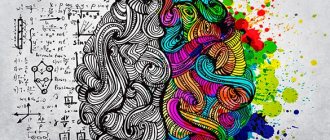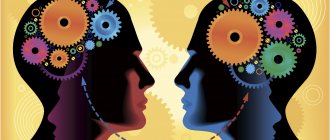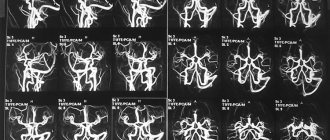Children with weakened right hemisphere function usually do well academically, but may have difficulties socially and behaviorally. Our brain consists of two hemispheres. Children with behavioral, academic, social or other problems often have an imbalance where they preferentially use one part of the brain. This causes one side of the brain to become stronger while the other develops more slowly.
Although research has shown that we use our entire brain to process information, children tend to exhibit characteristics associated with the "dominance" of different hemispheres of the brain. It was once believed that the brain was static, unable to grow or change. But extensive research and in-depth study of epigenetics have shown that the brain is remarkably adaptable, capable of creating new neural connections in response to stimuli in the environment. This is a branch of science called neuroplasticity.
Understanding the different brain responses can have a big impact on how your children learn. Problems most commonly reported by children and adolescents due to the apparent dominance of one hemisphere when processing information include:
- Tendency to get distracted and problems concentrating
- Uneven attention to detail
- Problems with time management
- Problems with organization
- Impulsiveness
- Mood swings and behavioral fluctuations
- Sensory processing problems
Brain Balance does not require the child to have a medical diagnosis, and we are not talking about clinical diagnosis of diseases. In this article, we focus on understanding the challenges these children face and helping them develop and strengthen neural connections. Research has found that the unique challenges your child faces may be related to weak connections in different areas of the brain. Fortunately, homeschoolers (virtually every homeschooler these days) have endless opportunities for creativity, individualization, and effectiveness in meeting the needs of right-brain dominant children.
What if your child is right-brain dominant?
Scientists have proven that children with a strong left hemisphere love structure, focus on details, love organization and logic. They can easily express their feelings and thoughts in words. Memorization comes easily to them, and left-brain dominant students tend to learn best through repetition. These children work efficiently using a step-by-step approach, enjoy working independently, have a good sense of time, and are objective.
Writing and spelling tend to come easily to these students, and they tend to learn well “by instruction.” Arithmetic, with its logical sequential steps, is also a subject in which left-brain dominant children often excel, although conceptual math subjects such as geometry or chemistry may be more difficult for them. Children with a strong left brain tend to benefit from auditory learning and often demonstrate academic ability early.
On the other hand, right-brain oriented students have visual abilities. They focus on holistic concepts rather than details and tend to be unstructured and impulsive and creative. They often demonstrate mastery of art or music. These children do not like to work independently; They learn best through discussion, interaction, collaboration and active participation in what they are learning.
Right-brain dominant children think in pictures rather than words, typically have a good sense of spatial orientation (but a poor sense of time), and are attuned to emotions. These children prefer the main idea to the details and often learn in spurts rather than in a consistent sequence. Right-brain oriented learners often reach conclusions intuitively without knowing what steps they took to arrive at the answer, and often prefer a visual or kinesthetic learning style. Children with a right-brain orientation are often “late bloomers” academically.
Meditation
Meditation techniques enhance the ability to control thoughts and emotions; in addition, the person receives all the benefits of α waves. The basic principle is to focus on a specific subject (breathing, imagining colors). It is important not to pay attention to other thoughts that appear during meditation. The object of meditation serves as an anchor to which a person returns when he loses attention. After a certain period of time, enhanced mental, spiritual abilities will be transferred into ordinary waking life.
How to meditate:
- Find a comfortable place that makes you feel good. Close your eyes, relax. The goal is not to empty your head of thoughts, although that is desirable. Let them fly as they please. Spread your arms slightly (enough for your elbows to be close to your body with your forearms slightly apart). Turn your palms so that one is pointing up, the other is pointing down.
- Imagine that with one hand, using the power of your mind, you press the ceiling, as if you want to break through it. The harder you “push”, the better. With your other hand, do the same, but pressing into the floor. Hold for several tens of seconds or a couple of minutes.
- Now place your palms opposite, imagine how you apply the force of one hand against the other. Hold again for several tens of seconds or minutes, as in the first exercise.
- Switch hands and repeat the pressure on the ceiling and floor.
- Repeat as desired, but don't overdo it. The optimal number of repetitions is five.
- Keep your eyes closed and feel the sensations around your head. Then slowly open your eyes and remain in a meditative position for a while.
What if your child is left-brain dominant?
In another study, researchers focused on the "superpowers" of children whose left hemisphere apparently dominates behavioral patterns. The left hemisphere of the brain controls learning and information processing. Children with a weak right hemisphere tend to be more analytical in their thinking and usually do well academically. They are better at remembering large amounts of data, have a large vocabulary and are detail oriented.
If your child is left-brain dominant, you will notice that he or she exhibits certain characteristics at home. For example, he or she may stick to the same routine, such as eating the same foods for breakfast, lunch, and dinner. Children who are left-brain dominant are also good at following directions.
One of the most noticeable characteristics of left-brain dominance is a tidy room. If you rarely tell your child to clean up, he or she may be left-brain dominant. As helpful as this can be at home, you may notice that many children with a strong left brain are not very emotional or affectionate. Instead, they tend to be logical thinkers and often enjoy spending time alone, according to Funderstanding.
Determination of hemispheric specialization
Already in the 19th century, scientists discovered that traumatic brain injury in some places in the left hemisphere is associated with impaired speech ability. Significant contributions to the theory of functional specialization of the hemispheres in the 1960s were made by neuroscientist Roger W. Sperry, who received the Nobel Prize.
Sperry worked with epileptic patients. To prevent the spread of epileptic seizures from one hemisphere to the other, he crossed the patient's corpus callosum. Epileptic seizures disappeared, and the person was able to return to normal life. At the same time, however, "special behavior" was observed after such a procedure. Thanks to this, Sperry achieved the theory of synchronization of the cerebral hemispheres. It should be noted that this procedure is still performed in some cases today, but with the help of modern technology, and only a small part of the corpus callosum is removed.
Children with a weak right hemisphere at school
Parents aren't the only people who may notice left-brain dominance patterns in children. Teachers also often notice characteristics based on how left-brained children behave in school. The good news is that according to Psychology Today, schools typically cater to children with weak right brains because most classes require strong analytical skills. Children with weak right-brain characteristics tend to excel in:
- Science
- Mathematics
- Reading
- Memorization
- Setting goals
Many of these children prefer to study alone, so make sure your child has a quiet place to do homework. Also, since many children with right-brain weakness tend to do well with lists, give your child the opportunity to make as many lists as possible by providing a board, paper, and writing utensils. Not only will your child be grateful for the help, but they will also likely be successful at school and at home.
Mindfulness
The mindfulness technique is very useful; it quickly relaxes the body and calms the mind. The technique is based on the principle of classical meditation, simple yoga exercises, the present moment and information from modern psychology (working with emotions, stress). The subject of meditation here is, in addition to breathing, sensations in individual parts of the body. It's an excellent way to reduce stress and encourage clear, creative thinking. The effect on the development of brain activity is confirmed by a number of studies.
David Gelles (journalist and lecturer on mindfulness) in his book “Mindfull work: How Meditation is Changing Business from the Inside Out” describes the positive impact of meditation and mindfulness training in such large companies as Ford, Google, General Mills, etc. mindfulness involves both senior management and interested ordinary employees. The first benefit of the training is overall employee satisfaction, more effective and less emotional decision-making, reduced stress, increased creativity, and productivity. According to experts, it is the synchronization of the brain hemispheres that is responsible for such effects.
How can you use this information to help your child?
If a child has a weak right hemisphere, he may be socially immature and have little interest in sports or outdoor activities. Instead of forcing your child to take karate and ballet classes, help him develop his super powers. Send your child to a STEM school, take programming courses, buy him supporting literature on physics, biology, or even a foreign language.
Scientists involved in brain neuroplasticity recommend that parents do not strive for “absolute brain balance.” (For example, trying to compensate for a love of science with sports endeavors.) Development of your child’s abilities, if it does not have clinical prerequisites (Attention Deficit Hyperactivity Disorder (ADHD), Oppositional Defiant Disorder (ODD), Processing Disorders (APD), Visual, Sensory Disorders (SPD), Learning Disorders (Dyslexia, Dysgraphia, Dyscalculia, Dyspraxia) do not require outside intervention.
Working with the left hemisphere can help a child with a predisposition to art, as well as a child who loves physics. Moreover, the development of the left hemisphere eliminates problems of concentration and distracted attention, regardless of which hemisphere is dominant. Our team is ready to help you. Take a second to fill out our form.
Find out more about it
You don't need to be Da Vinci to sharpen your mind, says Michael Candle.
The first person to write about the use of two-handed writing in personal therapy was art therapist Lucia Capaccione, who published The Power of the Other Hand in 1988. Her numerous works and publications describe how this technique can be used for the creativity and development of adults, adolescents and children. The exercises she suggests make it easier to learn two-handed writing - like riding a bicycle, this is a path from awkwardness and clumsiness to simplicity and naturalness. In 2021, another book by Capaccione was published in Russia - “The Art of Finding Yourself. Expressive diary."
Workouts for children
The following exercises are performed by a group of children; The classes are suitable for kindergarten.
Legs - arms
Goal: support the development of synchronization of the cerebral hemispheres, motor skills, and rhythmic senses.
Children stand in a circle. Instructions: which leg starts the exercise, a signal is sent there. The teacher transmits the signal: stomps his left foot, then his right. The signal follows in a circle to the left, each child starts with the left foot, then stomps with the right.
Dance
Goal: support the development of synchronization of the cerebral hemispheres.
Children stand in a circle. Take 4 steps forward. At the first step, clap your palms. In the same way, when returning to the starting position - 4 steps back, on the 1st step - clap the palm.
Variations:
- children repeat the basic pattern: 4 steps forward and back, clapping on every 2nd step;
- children repeat the basic pattern: 4 steps forward and back, clapping on every 3rd step;
- children repeat the basic pattern: 4 steps forward and back, clapping on every 4th step.
Yawn
Normal yawning can do more for the brain than it seems. It maintains the balance of many energy systems in the body, relaxes the cranial area, relaxes breathing, and improves perception.
How to develop your brain so that it works at 100%
The starting point for brain development is usually growing dissatisfaction with one's success in school, work or business. Most people begin to think about how to develop their intellectual and creative abilities when they encounter real difficulties in one of the areas of life. A person lives most of his life and only in adulthood realizes the importance of self-development. For this reason, among mature people there is a higher percentage of happy, successful and rich people than among young people, even though young people have more energy and enthusiasm.
For some reason, we are taught to pay more attention to the external, forgetting about the internal. Although the external is just a mirror reflecting the internal. And this also applies to the brain. You just know you have it from your high school biology course. But you don’t realize that it needs to be developed. But this is our main computer with 86 billion neurons! According to research, the average person uses only 3-5% of their brain potential! Imagine if your computer or laptop worked with such power. I think you would break it on the third day or go straight to the nearest store to “upgrade”.
Therefore, unfortunately, it must be said that most abilities for people remain beyond the realm of possibility, something from the realm of fantasy. And the reason for all this is simple: the brain works as it has to.
I would immediately recommend watching a very fascinating film on this topic called “Areas of Darkness.” The main character Eddie, a New York writer, wanting to overcome a bad streak in life, begins to take a secret drug called NZT. This creative drug allows him to develop his brain to incredible power. In a short period of time, his whole life changes. He writes a book, makes a lot of money and becomes successful. But he soon begins to suffer from the side effects of the drug.
By the way, many people do this. They resort to drugs because they are unable to realize their creative potential. I also write a lot and there are real stagnations when you can’t even string two lines together. But the thought never occurred to me to start using drugs for this purpose. I believe this is the path of weak people who have not bothered to simply take and understand how our brain actually works and what is necessary for intellectual and creative development. I already have my own experience, thanks to which I have developed my safe NZT and swallow it every day! We will talk about it, but a little later.
First, let's be clear that brain development is no easy task! It is necessary to do the following chain of actions:
1. Determine the dominant hemisphere
2. Develop the lagging hemisphere
3. Synchronize and increase the speed of switching work between them
You need to develop your brain harmoniously!
Exercises to develop interhemispheric connections
Games for children aged 2 years and older
Objectives: develop concentration and fine motor skills.
All exercises must be performed alternately with both hands.
- "Feed the bird." Take two bowls, different spoons (dining room, dessert, tea). They ask the baby to use spoons to pour peas and beans from one container to another, first with his right and then with his left hand. You can gradually increase the distance between them.
- Logorimics. Doing exercises and speaking words at the same time.
- Neurodynamic gymnastics. It includes various gross motor exercises: swimming, cycling, crawling on all fours. Gymnastics develops dexterity, spatial orientation, and fine motor skills.
Games for younger students
Including these exercises in the educational process allows you to better assimilate the material. They also help develop attention, concentration, and thinking.
- "Drawing with mirroring." You'll need a blank slate. The child must take any writing instruments in both hands and at the same time draw symmetrical pictures (letters, numbers, patterns). In the process, the limbs and eyes relax and the efficiency of the brain increases. The exercise can be performed using workbooks or special copybooks.
- "Lezginka". The right hand is folded into a fist and the thumb is placed to the side. And with the same hand, located horizontally, they touch the left little finger. Change sides. Repeat the movement 6-8 times. It is necessary to achieve a high speed of changing sides.
- "Rings." They alternate between the thumb and index finger, then the thumb and middle finger, and so on. Perform first separately, then together.
- "Nose and ear." With your right hand you touch the tip of your nose, and with your left hand you touch the opposite ear. Then they simultaneously release, clap their hands and quickly change hands.
- "Cross Movements" Raise your right leg up and touch it with your left hand. And vice versa.
- "Eight". Draw the number 8 in the air, first with one hand, then with the other. Then use both hands at the same time, carefully watching the movements.
- "Cross Steps" The exercise is performed standing or sitting. Raise your right knee and touch it with your left hand. Then change sides and repeat the exercise. Perform slowly, feeling all the abdominal muscles.
- "Dance". The adult makes simple movements in front of the baby, and he performs them in reverse. For example, you squat - the child stands up, you raise your hands - the child lowers them, etc.
- “Name the object.” The baby must quickly name the surrounding objects without repeating himself. Suitable for playing on the road or while walking.
All exercises must be performed at ease, in a calm environment, so as not to cause negative emotions in the baby. Be patient and everything will work out!










